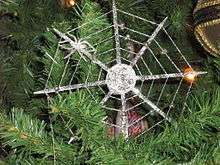Legend of the Christmas Spider
The Legend of the Christmas Spider is an Eastern European folktale which explains the origin of tinsel on Christmas trees. It is most prevalent in Western Ukraine, where small ornaments in the shape of a spider are traditionally a part of the Christmas decorations.
| Legend of the Christmas Spider | |
|---|---|
 A Ukrainian spider web ornament from the Christmas Around the World 2007 exhibit of the Museum of Science and Industry, Chicago | |
| Folk tale | |
| Name | Legend of the Christmas Spider |
| Data | |
| Country | Ukraine, Germany, Poland, Denmark, Norway, Sweden, Finland, Russia |
| Region | Europe |
Story
A poor but hardworking widow once lived in a small hut with her children. One summer day, a pine cone fell on the earthen floor of the hut and took root. The widow's children cared for the tree, excited at the prospect of having a Christmas tree by winter. The tree grew, but when Christmas Eve arrived, they could not afford to decorate it. The children sadly went to bed and fell asleep. Early the next morning, they woke up and saw the tree covered with cobwebs. When they opened the windows, the first rays of sunlight touched the webs and turned them into gold and silver. The widow and her children were overjoyed. From then on, they never lived in poverty again.[1][2]
Variants
Other versions replaces sunlight with a miracle from Father Christmas, Santa Claus, or the Child Jesus, and tells the story primarily from the perspective of the spiders who wished to see the Christmas tree.[3][4][5][6]
Origins
The origins of the folk tale are unknown, but it is believed to have come from either Germany or Ukraine.[7][8][6] In Germany, Poland, and Ukraine, finding a spider or a spider's web on a Christmas tree is considered good luck.[9] Ukrainians also create small Christmas tree ornaments in the shape of a spider (known as pavuchky, literally "little spiders"), usually made of paper and wire. They also decorate Christmas trees with artificial spider webs.[10] The tradition of using tinsel is also said to be because of this story.[3][2][11]
According to Lubow Wolynetz, folk art curator at Ukrainian Museum, New York City, the tradition is Ukrainian and dates back to the late 1800s or early 1900.[12]
It may be based on an older European superstition about spiders bringing luck (though not black spiders in Germany),[8] or conversely that it is bad luck to destroy a spider's web before the spider is safely out of the way.[3]
See also
- Cultural depictions of spiders
- "The Fir-Tree", Hans Christian Andersen tale about a Christmas tree
- Ukrainian folklore
References
- "Christmas Around the World and Holidays of Light: Slovenia to Wales". Museum of Science and Industry, Chicago.
- "The Ukrainian Tradition of Spider Webs and Christmas". Ukraine.com. Retrieved 6 December 2014.
- DeeAnn Mandryk (2005). Canadian Christmas Traditions: Festive Recipes and Stories From Coast to Coast. James Lorimer & Company. pp. 56–57. ISBN 9781554390984.
- "Legend of the Christmas Spider". Spider Wisdom. 19 December 2010. Retrieved 6 December 2014.
- Julia Goralka (11 December 2011). "A Christmas tree, Jesus, and a spider". Washington Times. Retrieved 6 December 2014.
- "Tabletop Trees: Tinsel Tree". Martha Stewart Living. December 2001. Archived from the original on 4 December 2014. Retrieved 6 December 2014.
- Orysia Paszczak Tracz (31 December 2006). "A spider for Christmas?". The Ukrainian Weekly. 74 (53).
- Barbara Klumb (20 December 1978). "Spider Tale Spins a Web of Holiday Yore". The Milwaukee Journal: 1, 3.
- Arlene Erlbach (2002). Merry Christmas, Everywhere!. Millbrook Press. p. 42. ISBN 9780761319566.
- "The wonderful and weird Christmas traditions around the world". Punchline. 11 December 2011. Retrieved 6 December 2014.
- "Ukrainian Christmas Spider Ornaments". Solovei Magazine. 8 December 2011. Retrieved 6 December 2014.
- https://www.today.com/home/spider-ornaments-christmas-trees-symbolize-good-luck-t120335%5B%5D